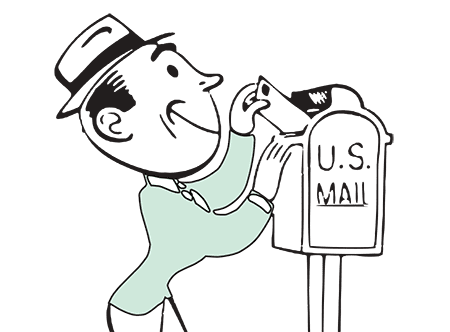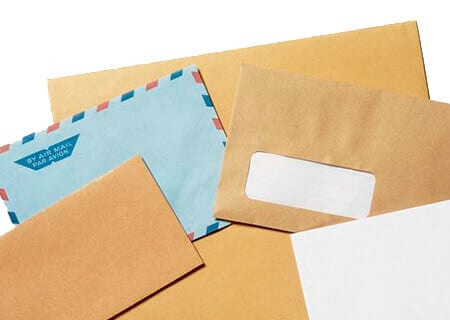It’s never a bad time to use your manners. But when do you send thank-you letters? People can often feel the love just fine without it. Other times, mailing a thank you note is best to express gratitude and keep tabs on the relationship.
7 Tips for Thank-You Letters (and When Not to Trouble Yourself)
Running a business, church, or non-profit after the holiday season, you’ll probably have a few thank-yous up your sleeves: to customers, volunteers, staff, gift-givers, and well-wishers. You may be wondering how and when to send those post-holiday thank-yous.
Here’s a little guide on being polite, while still paying attention to time and budget.
When to send thank-you letters
Hand-written notes or personalized letters are a fairly easy way to make contact with the warmth of a personal touch. They’re a gesture of appreciation that never goes out of style. They show you care, and that you pay attention to details.
But it is one more thing on your to-do list. So you want to make sure a thank-you isn’t superfluous and that it’ll be appreciated.
Here are some signs that tell you when it’s probably best to send a thank you note:
- Leadership, the office, or the organization received a small to medium gift that didn’t already receive an in-person thank-you.
- Any of the above received a large gift, even if a thank you was already said in person. (If you suspect it’s a large gift, it’s better to err on the side of a thank you note than not.)
- The organization received a donation. It’s always nice to send a mailed thank-you to all donors, at least once a year, to express gratitude, no matter the amount given. And don’t forget those tax deduction forms!
- Volunteers or staff offered time “off the clock” to contribute to a holiday cause and were not already thanked or compensated personally (such as with a gift card, public acknowledgment, special coffee hour, etc.).
If your circumstance doesn’t match these, it’s likely you don’t need a formal thank-you. However, that doesn’t mean you don’t say thanks! General public acknowledgments, phone calls, and emails can also do the trick.
Who writes thank you letters anymore?
Individuals and organizations write thank you letters and send them through the mail. Businesses, churches, and non-profits often send thank you letters in return for significant gifts, donations, or unpaid service rendered, and consider them a significant part of marketing strategy.
Tips and tricks for mailed thank you letters
Here are some tips and tricks for keeping your thank-yous well organized, timely, and snazzy.
1 – Keep lists of those who give.
This isn’t just the Benjamins. Keep account of who gives time or donates other goods and services. Not only will you need those lists for thank-yous and tax season, but for marketing and relationship building. For example, knowing who’s been your most faithful volunteers over months and years will help you know who to honor most, but also who to avoid burning out with volunteer requests.
2 – Make a firm sending date.
It’s best to send a thank-you within a week of receiving a gift or favor. If you have many gifts coming in at once (because of, say, a donation deadline), your general thank-you letter needs a quick and solid deadline falling no more than two weeks after the final giving deadline.
3 – Use donation tracking tools.
If you have the donor tracking technology, a rolling system of thank-you letters could be ideal, in which you have an individual thank-you note hitting the post office a certain number of days after each donation, rather than waiting until a deadline and sending them all at once. Consider your tech and your audience to determine how you send thank-you letters, but definitely stick to a date!
4 – Keep mailing lists clean.
If you need some tips for “spring” cleaning your address books, no matter what time of year, we’ve got you. Just make sure you’re doing it regularly, and that you’re getting contact info from those key people in your relationship network or your marketing funnel. If loyalty is key to building an organization, these are the folks that need to be getting the primo treatment in your databanks.
5 – Include a gift (maybe).
If appropriate and you have the budget, consider a small gift with your thank-you note. That can be anything from a special discount to a gift card (such as $5 at Starbucks or a local coffee joint), to the link for a video greeting from the pastor. Make sure that if you’re including a physical object, there’s room in your envelope!
Note: gifts don’t typically apply to donations of tangibles (like clothes, toys, money), unless they’re an expected part of the giving cycle, like a pledge drive. They’re more commonly sent as thank-yous for intangibles like time and volunteering.
6 – Tailor to your audience.
People who donate small amounts don’t expect a grand gesture of thanks, like a personal handwritten note from the CEO. Bigger donors will. But neither group will expect you to spend a bunch of money on thank you letters. When you tailor thank-yous to your audience, the main thing to tailor is the level of personalization and time taken with each one.
7 – Keep it short and sweet.
You want to make the best use of your time. So do the people you’re thanking. Keep the design of your card clear and simple, and your copy short and sweet. A picture also says plenty. For example, a snapshot of the staff or the volunteer day with a simple “Thanks for _______!” (fill in the blank) can say quickly what you need and build a memory or emotional connection as well.
When and how should I write a business thank you letter?
Businesses, churches, and non-profits should send thank you letters for significant gifts, donations, or unpaid service rendered, and consider them a significant part of marketing strategy. Letters should be short, warm, tailored to the audience, and need to have a firm sending deadline.
A final “note” on branding
Hopefully, now you’re ready to design your campaign! Remember to keep it simple, but don’t forget to brand. A thank-you isn’t another sell, but consistent communications are part of a winning marketing strategy.
Whether you need a customized envelope for a new campaign or a stash of stable go-tos, Letter Jacket Envelopes loves to put it together. Just get in touch with your idea, and we’ll help you make it happen for a great price—with free shipping on your first order!



